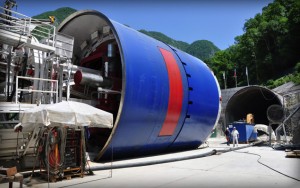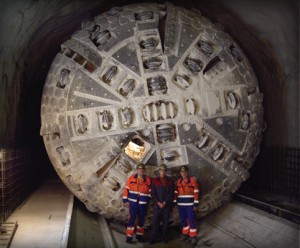Archives: Projects
Emisor Oriente
Three Robbins EPBs bore Vital Wastewater Tunnel in Mexico
Project Overview
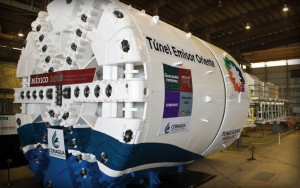 In an urgent effort to prevent flooding in the urban capital of Mexico City, the National Water Commission (CONAGUA) has ordered the construction of a 62 km (39 mi) long wastewater line, Emisor Oriente, which is expected to help increase Mexico City’s wastewater capacity and ease some of the city’s related problems. Torrential rains and continuing floods in Mexico’s capital during the rainy season have increased the urgency of the job, quickly making it the country’s most critical infrastructure project.
In an urgent effort to prevent flooding in the urban capital of Mexico City, the National Water Commission (CONAGUA) has ordered the construction of a 62 km (39 mi) long wastewater line, Emisor Oriente, which is expected to help increase Mexico City’s wastewater capacity and ease some of the city’s related problems. Torrential rains and continuing floods in Mexico’s capital during the rainy season have increased the urgency of the job, quickly making it the country’s most critical infrastructure project.
The Emisor Oriente project was divided into six lots – Lots 1, 2 and 5 awarded to Mexican contractor Ingenieros Civiles Asociados (ICA), S.A. de C.V., Lots 3 and 4 to Carso Infraestructura y Construcción, S.A. de C.V., and Lot 6 to Lombardo Construcciones and Constructora Estrella. Three 8.93 m (29.3 ft) Robbins Earth Pressure Balance Machines (EPBs) are excavating Lots 1, 3, 4, and 5 of the tunnel.
Geology
Mexico City is located in the Valley of Mexico. The area contains an ancient, drained lake bed and is surrounded by volcanic mountain ranges. The soil is mainly made up of watery clays running up to 80 m (263 ft) deep with the water table just 2 to 3 m (6.6 to 9.8 ft) below the surface. The ground also contains boulders up to 600 mm (24 in) in diameter. Due to the complex ground conditions, engineers believed for years that the ground would be too difficult to excavate. Despite the challenging terrain, Mexico City’s main wastewater line, Emisor Central, was hand-mined in 1964 approximately 100 m (328 ft) below ground, paving the path for future underground construction projects.
Equipment Features
The Robbins EPBs were designed for the particularly difficult ground conditions they would be facing on the job site. Although difficult ground was anticipated, shaft excavations in 2009 and 2010 revealed much more complex terrain than originally expected, resulting in various modifications on each machine. The EPBs were built with mixed-ground, back-loading cutterheads with carbide cutter bits to deal with variable ground conditions, and ribbon-type screw conveyors to remove large boulders. Redesigned pressure bulkheads were added to the machines to accommodate the higher water pressures of the region, and enhanced wear detection was added to the cutter bits to ensure optimal performance. Robbins continuous conveyors are being used behind each machine in order to quickly remove muck from the jobsite and minimize downtime. Each continuous conveyor system and vertical belt is installed once the machines have bored ahead 150 m (492 ft) from their launch points.
Excavation
One Robbins EPB was launched for Lot 1 on July 13, 2011 – a change from its originally scheduled tunnel drive at Lot 5. A flood at Lot 1 delayed the Herrenknecht machine that was originally designated to bore the area for six months, prompting the contractor to begin boring with the Robbins EPB. The machine started excavation at shaft 5 of Lot 1 using umbilical cables connected to the surface and a sludge pump for muck removal.
Excavation at Lot 1 was fast-tracked because of problems with Mexico City’s main open sewer line, the Gran Canal. The canal was constructed in 1910 and floods its banks on a regular basis, causing road closures and significant health problems to the city’s residents. The canal has a positive vertical alignment, resulting in potentially large volumes of water that could overload current pumping stations and send untreated water back into the city. The canal’s slope loss is due to the area’s sinking lake clays. To help remedy this problem, a treatment plant and pumping station are being constructed in shaft 5 of Lot 1 so water diverted from the section of the Gran Canal to Emisor Oriente can be pumped back into the Gran Canal where the slope has not been compromised. Although there were many challenges the first EPB machine had faced, it was able to make a successful breakthrough 15 months later. Once the Robbins EPB had bored its 4.6 km (2.9 mi) drive to shaft 3A of Lot 1, it was dismantled, removed, reassembled at Lot 5, and began boring its original 8.6 km (5.3 mi) long bore in early 2014.
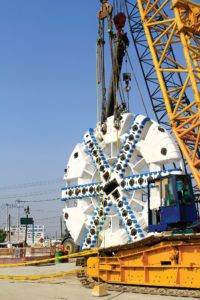 The remaining two Robbins EPBs started excavation in 2012, working on 9.2 km (5.7 mi) and 10.2 km (6.3 mi) drives at Lots 3 and 4, respectively. Once excavation was initiated, the machines quickly encountered sections of abrasive basalt rock and ash, boulders and blocky ground that wore on cutting tools and the cutterhead. As a result, the harsh ground conditions led to accelerated wear and damage on some of the cutting tools as well as the screw conveyors.
The remaining two Robbins EPBs started excavation in 2012, working on 9.2 km (5.7 mi) and 10.2 km (6.3 mi) drives at Lots 3 and 4, respectively. Once excavation was initiated, the machines quickly encountered sections of abrasive basalt rock and ash, boulders and blocky ground that wore on cutting tools and the cutterhead. As a result, the harsh ground conditions led to accelerated wear and damage on some of the cutting tools as well as the screw conveyors.
In efforts to manage the sudden impact of the challenges faced and to maintain control of the situation, the operational parameters at Lots 3 and 4 became a high priority. Improvements to the cutter change time on the central disc cutters were made possible with the design of a new rotary union. To reduce the abrasive wear on the cutterhead, more durable face and gauge scrapers were added to the cutterhead.
The Lot 3 machine underwent additional changes after boring 2.7km (1.6 mi) of its tunnel. The machine was given a new cutterhead fitted with chromium carbide wear plates and smaller openings to reduce blockages. The machine also get a new screw conveyor design with special wear plates, and a reinforced casing with additional gates and injection ports.
At Lot 4, the other Robbins Machine has fared better in soft rock, despite having a lot of water pressure to deal with—the machine even holds the shift record for the project, of 28 rings.
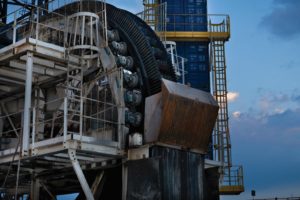 The Lot 5 Robbins machine, which came from Lot 1, needed major modifications before starting at Lot 5 to help deal with expected water pressures up to 7 bar. The TBM—launched from the deepest shaft at a civil works project in Mexico (150 m)—was fitted with new hyperbaric chambers, as well as a new gantry for the compressors and air tanks. To speed up disc changes at the center of the cutterhead, the rotary union was also modified.
The Lot 5 Robbins machine, which came from Lot 1, needed major modifications before starting at Lot 5 to help deal with expected water pressures up to 7 bar. The TBM—launched from the deepest shaft at a civil works project in Mexico (150 m)—was fitted with new hyperbaric chambers, as well as a new gantry for the compressors and air tanks. To speed up disc changes at the center of the cutterhead, the rotary union was also modified.
Project Completion
On May 23, 2019, the last of the six 8.93 m EPBs completed tunneling at Lot 4 of Emisor Oriente, thus ending a ten year campaign of nearly 63 km of tunneling in some of the most arduous conditions crews have ever come across.
With the tunneling complete, the secondary lining operation also had to take place from the various headings using telescopic forms. The tunnel was opened for use in December 2019.
Xi'an Metro Line 1 Lot 12
Robbins EPBs excavate beneath Ancient Chinese City
Project Overview
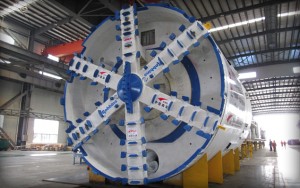 In June and July 2010, commencement of Xi’an’s Metro Line 1 began with the launch of two Robbins machines from Changlepo towards Wanshou Road Station—the first TBMs tunneling on the project.
In June and July 2010, commencement of Xi’an’s Metro Line 1 began with the launch of two Robbins machines from Changlepo towards Wanshou Road Station—the first TBMs tunneling on the project.
Xi’an’s 26.4 km metro Line 1 will run from north to south through the downtown area. Ten TBMs, including two 6.2 m diameter Robbins EPBs, excavated the new rail route. The route travels directly below some of the 3,100 year old city’s most sensitive heritage sites, including the terra cotta warriors.
The Robbins EPBs excavated Lot 12 of Line 1 for the 11th Bureau of China Railway Construction Corporation (CRCC). The parallel 3.6 km tunnels pass through four cut and cover station sites—Changlepo, Wanshou Road, Kangfu Road, and Jinhua Road—under shallow cover ranging from 8 to 22 m. The two TBMs were the first to start excavation on Line 1, and were followed by eight other machines excavating their respective lots.
A total supply contract was signed with China Railway 11th Engineering Bureau Group Limited in June 2009. The second machine assembly was completed in April 2010 at a nearby manufacturing facility in Chengdu before being shipped to the jobsite.
Geology
Both Robbins machines were optimized for geology including sand, abrasive pebbles and clay with significant ground water. Spoke-type cutterheads and 800 mm (32 in) diameter shaft-type screw conveyors aided in efficient advance while maintaining a water-tight seal and balanced pressure.
Tunnel Excavation
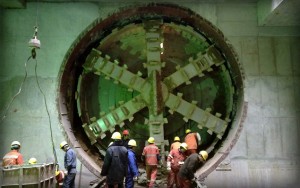 The Lot 12 section was located in a densely urban area, with the tunnels traveling below a college, a hospital, and a marketplace. Crews continuously monitored the excavation rate and overall muck removal volume, by adjusting the thrust force, advance rate, and screw conveyor speed, while keeping the cutterhead speed low, at 1 rotation per minute. Sections of collapsible, water bearing soils were also present in early sections of the tunnel alignment. Crews approached these sections with similar measures, including strict earth pressure control in the mixing chamber, paired with injection of bentonite and water for soil conditioning.
The Lot 12 section was located in a densely urban area, with the tunnels traveling below a college, a hospital, and a marketplace. Crews continuously monitored the excavation rate and overall muck removal volume, by adjusting the thrust force, advance rate, and screw conveyor speed, while keeping the cutterhead speed low, at 1 rotation per minute. Sections of collapsible, water bearing soils were also present in early sections of the tunnel alignment. Crews approached these sections with similar measures, including strict earth pressure control in the mixing chamber, paired with injection of bentonite and water for soil conditioning.
Tunnelling was made even more complex by a city-wide ordinance limiting settlement to ± 15 mm; significantly less than the 25 mm limit that is typical of most Chinese tunnelling projects. The strict settlement guidelines, implemented out of caution due to the ancient structures, required specialized designs for the two Robbins EPBs.
The last intermediate breakthrough, at Jinhua Road station, occurred on July 28, 2011. Advance rates for the Left Line EPB were good—up to 579 m (386 rings) per month and 36 m (24 rings) per day. Planned maintenance was performed while in the cut and cover area, such as changing of cutters and tail seal brushes as well as checkups of the hydraulic system and electrical system. Semi-segment rings consisting of the invert and two segments were installed to allow the machine to ‘walk’ through the 140 m long station site.
Advance rates for the Right Line machine were similarly high—up to 453 m (302 rings) per month and 39 m (26 rings) per day. Settlement was kept below 15 mm with an average settlement of 5 mm.
By summer 2011, one machine had recently completed its second section of tunneling between Wanshou Road and Jinhua Road, and the other was on its last section between Jinhua Road and Kangfu Road in layered loess conditions.
The machines completed tunneling within the project schedule in the last quarter of 2011.
Сочинский комплекс 3
ТБМ Компании Роббинс строит дороги для Олимпийских Игр
Обзор проекта
При подготовке столицы Зимних Олимпийских Игр 2014 года две тоннельные буровые машины (ТБМ) Компании Роббинс завершили в срок проходку тоннелей в Сочи. Помимо строительства новых Олимпийского парка, линий водоснабжения, электростанций и спортивных арен, город-курорт хочет быть уверенным, что транспорт не станет проблемой для его гостей. Согласно проекту развития транспортной инфраструктуры, поделённому заказчиком – ДКРС-Сочи, на шесть комплексов, Адлер, маленький городок на черноморском побережье, и горный курорт Альпика будут связаны между собой новой магистралью, состоящей из автомобильной дороги и железнодорожных путей. Эти линии с 46 мостами и 12 тоннелями пройдут вдоль реки Мзымта через национальный лесной заповедник и будут связаны с федеральной автодорогой М-27.
Длина новой совмещённой дороги – 48,2 км. Срок окончания строительства – июнь 2013 года. Для обеспечения жесткого графика строительства проходка тоннелей ведётся различными методами, включая применение проходческих комбайнов, буровзрывных работ и пяти ТБМ.
Переделка под проект
Для проходки параллельных сервисного и железнодорожного тоннелей длиной соответственно 5,8 км и 4,6 км подрядчики, ОАО Стройтрест и ЗАО Бамтоннельстрой, заказали две отремонтированные ТБМ. В условиях жесткого графика строительства машины, работавшие ранее на других проектах, были выбраны из-за более короткого срока их поставки в сравнении с поставкой новых машин. ТБМ диаметром 10,0 м работала ранее, в 2003-2006 годы, на строительстве железнодорожного тоннеля Абдаладжис в Испании и до отправки на комплекс 3 в Сочи находилась на хранении. Телескопная машина диаметром 6,2 м была построена в 1993 году для строительства гидроэлектростанции в Швейцарии и с тех пор работала на многих тоннельных проектах, пробурив в общей сложности свыше 45 км тоннелей.
Машина диаметром 10,0 м была поставлена в Сочи после ремонта, выполненного субподрядчиком поставщика. При монтаже ТБМ выявилось, что некоторые из главных компонентов машины нуждаются в ремонте или замене. По изучению вопроса, Бамтоннельстрой принял решение пригласить Компанию Роббинс для технического обслуживания ТБМ и сопровождения работ на Комплексе 3. Основанием этому решению служил довод, что две из трёх ТБМ, работавших на площадке, были построены Компанией Роббинс.
Команда из 15 специалистов сервисной службы и инженерных отделов Компании Роббинс отремонтировала и модифицировала обе ТБМ. Десятиметровая машина получила из Италии другую моторную плиту, тогда как её главный подшипник был отремонтирован на заводе в Германии. Для транспортировки 30-тонного подшипника использовался самолёт Антонов 124-100, единственный из существующих, способный перевозить такие тяжеловесы. На машине модернизировали также систему смазки, поддува полости главного подшипника и внесли изменения в систему смазки главных уплотнений.
Телескопная машина диаметром 6.2 м получила новые редукторы главного привода и программируемый логический контроллер. Команда Компании Роббинс оставалась на стройплощадке, пока обе машины не были отлажены и не приступили к нормальной работе.
Геология
ТБМ были специально спроектированы для бурения раздробленных и нарушенных осадочных пород, которыми представлен сочинский регион. При испытании образцов было установлено, что машины будут бурить, в основном, по известнякам при состоянии их от монолитных до сильнотрещиноватых с прослойками глины. Такие осадочные породы, как песчаники и алевролиты, были также выявлены наряду с зонами разломов, сложёнными брекчиями и конгломератами.
Для обеспечения устойчивости забоя обе машины были спроектированы с плоскими режущими головками, низкопрофильными породными ковшами и радиальными черпаками. Они были оборудованы, также, легко заменяемыми кромками черпаков. Для обработки породы пена и химические добавки могли в неё нагнетаться через специальные инъекционные порты.
Проходка тоннелей
ТБМ диаметром 6,2 м стартовала в марте 2010 года бурением по смешанным породам. Однако в мае машина остановилась, войдя в зону разлома, сложенную раздробленными и сыпучими породами. Бригадам удалось освободить машину путём ручной проходки вокруг ТБМ обходной штольни с деревянным креплением и последующего удалениям обломочника из камеры, пройденной впереди режущей головки. Для оценки состояния грунтов впереди машины были пробурены разведочные скважины на расстояние до 62 м. Обнаружилось, что впереди залегают сильнотрещиноватые породы. Для укрепления порфиров впереди и вокруг режущей головки, в них было проведено нагнетание полимерной пены. По завершении этих работ машина без проблем пошла вперед. Во избежание подобного в будущем, проходчики выполняли систематическое разведочное бурение на остающемся участке проходки и, при необходимости, обрабатывали породу цементно-силикатными композициями и пеной. Этим обеспечивалось стабильное движение машины вперёд.
Несмотря на эти вызовы природы, шестиметровая машина достигла хороших скоростей проходки – от 100 до 120 м в неделю и 14 м в день. 2 марта 2011 года произошла сбойка. По завершении проходки ТБМ была демонтирована и отправлена на хранение в район Новороссийска. Ожидается, что она будет использоваться на последующих тоннельных проектах, так как находится в хорошем состоянии и показала при работе на Комплексе 3 очень низкий износ шарошек.
Десятиметровая ТБМ стартовала в сентябре 2010 года и успешно преодолела два разлома протяжённостью 25 м и 50 м, сложенными сильновыветрелыми породами. Здесь также выполнялось разведочное бурение и предварительная обработка пород для их упрочнения.
Массивная машина закончила работу сбойкой, выполненной 14 февраля 2012 года
Zhengzhou Metro Line 1
Project Overview
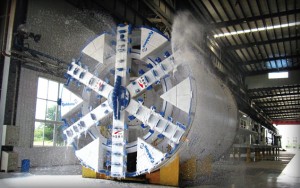 The Zhengzhou Metro consists of twin underground tunnels as part of a larger project for the 11th Bureau of the China Railway Construction Corp. (CRCC) to create the first metro system in the city. Approximately seven million people live in Zhengzhou so the new metro lines will help relieve congestion and allow Zhengzhou to become a center for rail commerce in China.
The Zhengzhou Metro consists of twin underground tunnels as part of a larger project for the 11th Bureau of the China Railway Construction Corp. (CRCC) to create the first metro system in the city. Approximately seven million people live in Zhengzhou so the new metro lines will help relieve congestion and allow Zhengzhou to become a center for rail commerce in China.
The future construction of up to four metro lines is planned for the area, with freight lines between Beijing and Guangzhou (North-South), and Xuzhou and Lanzhou (East-West) intersecting the city. Once complete in 2013, Line 1 of the metro will be 26 km (16 mi) long and include 22 stations. The Zhengzhou Metro Company has invested Yuan 10.2 billion (USD 1.5 billion/EUR 1.1 billion) in the new metro project. Once all lines have been completed – sometime between 2015 and 2030 – the entire metro line will stretch 188 km (117 mi).
Geology
Soft, powdery soils made up the first part of the drive. Line 1 involved excavation under urban areas of Zhengzhou with cover as low as 7 m (23 ft) for almost half the length of the tunnel. The drive also included a section of tunnel just 7.0 m (23 ft) below Xi Liu Lake, with depths of 1.0 to 2.0 m (3.2 to 6.6 ft). The terrain in this section consisted of permeable soil with underground water below the lake fed by vertical leakage, resulting in challenging ground conditions.
Equipment Features
The Robbins EPBs were designed using spoke-type, soft ground cutterheads with tungsten carbide knife-edge bits. The electric, variable speed drives power the cutterheads at 750 kW (1,005 HP), allowing them to rotate at a speed of 0.3 to 2.0 revolutions per minute. To remove liquidized muck, the EPBs are equipped with shaft-type screw conveyors 800 mm (31 in) in diameter, which take the muck to muck cars for extraction from the tunnel. The thrust rate of both EPBs is 36,000kN (8.1 million lb), with a maximum torque of 4,785 kNm (3.5 million lb-ft) and a maximum stroke of 1,950 mm (77 in).
Both machines were designed with active articulation, which allowed them to bore curves on small radii while keeping the segment lining of the tunnel intact. The segment lining was made of reinforced concrete, 300 mm (12 in) thick, in a 5+1 arrangement with each segment 1.5 m in length. To help stabilize the tunnel lining, one-liquid type backfill was injected between the segment lining and the soft ground to fill in temporary gaps and help minimize subsidence.
TBM Excavation
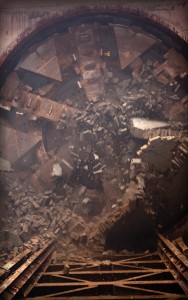 Each tunnel is 3.6 km (2.2 mi) long, passing through four intermediate stations between Kaixuan and Tongbo areas. The machines used on this project were manufactured at Chengdu CSR Tunnelling Equipment Co., Ltd. and launched in November and December 2010. Structural challenges in the low cover tunnel included a highway interchange bridge and building foundations nearby. Foam and bentonite were injected into the soil to improve its condition and reduce settlement. Following the successful completion of these sections, the machines achieved two intermediate breakthroughs into cut and cover sites in early 2011.
Each tunnel is 3.6 km (2.2 mi) long, passing through four intermediate stations between Kaixuan and Tongbo areas. The machines used on this project were manufactured at Chengdu CSR Tunnelling Equipment Co., Ltd. and launched in November and December 2010. Structural challenges in the low cover tunnel included a highway interchange bridge and building foundations nearby. Foam and bentonite were injected into the soil to improve its condition and reduce settlement. Following the successful completion of these sections, the machines achieved two intermediate breakthroughs into cut and cover sites in early 2011.
Line 1 of the Zhengzhou Metro was completed in October and November 2011, at least two weeks ahead of schedule. The two 6.3 m (20.7 ft) Robbins Earth Pressure Balance Machines (EPBs) have set a Chinese EPB record in their size class, excavating up to 720 m (2,362 ft) in one month. Daily advance rates of the machines reached 22 rings (33 m/108 ft) in two 10-hour work shifts. These rates additionally mark a project record compared to nine other machines that worked on the job
Tahoe Forest Hospital District Central Energy Plant Prep Project
Project Overview
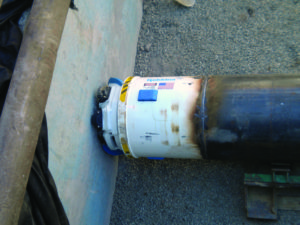 The Tahoe Forest Hospital is an expanding healthcare center located in Truckee, California. In autumn 2010, they were in the process of designing a new cancer wing when it was determined that additional utility and mechanical lines were required before the new building could be built. To house the bundled utilities, three crossings needed to be bored directly below the active main hospital.
The Tahoe Forest Hospital is an expanding healthcare center located in Truckee, California. In autumn 2010, they were in the process of designing a new cancer wing when it was determined that additional utility and mechanical lines were required before the new building could be built. To house the bundled utilities, three crossings needed to be bored directly below the active main hospital.
General contractor AM-X Construction & Excavation, Inc. subcontracted the three parallel 21 m (70 ft) sections to Silver State Boring Inc. Due to variable ground conditions and hospital noise constraints, the contractor opted for a Robbins SBU-A with a mixed ground head. This was the first time Silver State had used this type of cutterhead, but they were confident that it was the right machine for the job.
Geology
The hospital is set on ground containing large granite boulders, and Silver State was worried that one of these rocks would be hit during boring. This concern was actualized 7.6 m (25 ft) into the first bore when the SBU-A caught the edge of a boulder about 3.7 m (12 ft) in diameter. During the second bore, the machine drilled straight through the same boulder. Additional boulders of 175 MPa (25,000 psi) UCS were encountered during the third bore, and the SBU-A successfully powered through them as well.
What is a Mixed Ground SBU-A?
The Robbins SBU-A is a circular cutting head mounted with a combination of tungsten carbide bits, single disc cutters, and multi-row disc cutters. The SBU-A is available in diameters from 600 mm to 1.8 m (24 to 72 in), and can excavate a wide variety of hard rock and mixed ground conditions including dry soils, clay, cobbles and boulders from 25 to 175 MPa (4,000 to 25,000 psi) UCS.
During boring, the SBU-A is welded to an Auger Boring Machine (ABM), which provides both torque and thrust to the cutting head. Drag bits scrape soil from the machine face, while disc cutters excavate sections of rock. Muck scrapers scoop the excavated rock into large openings in the cutterhead, allowing for a smooth flow of muck from the face to the auger string.
Excavation
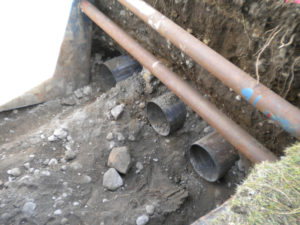 The SBU-A bored 2 m (8 ft) below the hospital’s foundation for the three jack-and-bore crossings. Straight bores were needed due to tight exit space, and each one began with a 609 mm (24 in) thick concrete starting block to keep the machine properly aligned. In addition, the older hospital has many buried utilities that needed to be cut and bypassed during site excavation. To make sure that everything would run smoothly, Robbins field service technicians visited the site prior to launch to assist with setup and crew training.
The SBU-A bored 2 m (8 ft) below the hospital’s foundation for the three jack-and-bore crossings. Straight bores were needed due to tight exit space, and each one began with a 609 mm (24 in) thick concrete starting block to keep the machine properly aligned. In addition, the older hospital has many buried utilities that needed to be cut and bypassed during site excavation. To make sure that everything would run smoothly, Robbins field service technicians visited the site prior to launch to assist with setup and crew training.
The first of the three bores began in October 2010, and by November 2010 all three bores were successfully completed. Advance rates for the duration of the project were approximately 3 m (10 ft) per day.
Due to the low torque and impact of the SBU-A, little stress was put on the ABM, no cutter changes were needed between bores, and the hospital was unaffected by noise or vibration during boring. Silver State was very pleased with the results, and used the technology again in 2011 for 609 mm (24 in) diameter bore in South Lake Tahoe, Nevada.
City of Clinton Contract B Force Main Project
Project Overview
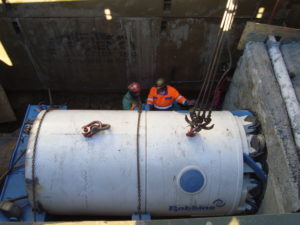 The Iowan towns of Clinton, Camanche and Low Moor have been identified as communities in desperate need of updated wastewater treatment systems. The towns all have over 10,000 residents, but their water and sewer treatment plants are inadequate and often over capacity. In 2009, a statewide recovery program called I-JOBS was created in Iowa, and USD $20 million in project funding was allocated to improving water quality. These funds were set aside for water treatment projects in the three towns.
The Iowan towns of Clinton, Camanche and Low Moor have been identified as communities in desperate need of updated wastewater treatment systems. The towns all have over 10,000 residents, but their water and sewer treatment plants are inadequate and often over capacity. In 2009, a statewide recovery program called I-JOBS was created in Iowa, and USD $20 million in project funding was allocated to improving water quality. These funds were set aside for water treatment projects in the three towns.
The City of Clinton awarded their portion of the funding, USD $9.5 million, to general contractor Merryman Excavation. Illinois-based L.J. Keefe Co. was chosen as the sub-contractor for the project. The contract, known as City of Clinton Contract B Force Main, called for six crossings below roadways and rivers, three of which required TBM tunneling. The remaining three crossings required SBUs. Two Robbins SBU-As were chosen for the 26.2 m (250 ft) and 82.3 m (270 ft) runs, and a third Robbins motorized SBU (SBU-M) was selected for the 120.4 m (395 ft) crossing.
Geology
The 26.2 m (250 ft) and 82.3 m (270 ft) crossings undercut the Mississippi river, and were identified as hard rock bores of over 70 MPa (10,000 psi) UCS in which SBU-As would be the best choice. The longest crossing was below traffic-heavy Highway 67, and testing of the area revealed a mixed face of sand, clay and 70 MPa (10,000 psi) UCS hard rock. Due to the variable ground conditions, the contractor opted for a 1.8 m (72 in) SBU-M, the largest of its kind yet built.
About the SBU-A
The Small Boring Unit (SBU-A) is a hard rock and mixed ground circular cutterhead which utilizes an Auger Boring Machine (ABM) and steel casing. During excavation, the SBU-A is welded to the lead casing while the ABM provides torque and forward thrust to the cutterhead.
The SBU-A is available in diameters ranging from 600 mm to 1.8 m (24 to 72 in), and its single disc cutters are capable of excavating rock from 25 to over 175 MPa (4,000 to over 25,000 psi) UCS. The cutters penetrate the rock face, creating a “crush zone” through which fractures occur. Material between adjacent crush zones falls from the face into muck buckets in the cutterhead. A full face auger is used to transfer the muck for removal.
About the SBU-M
The SBU-A’s cousin, the SBU-M, is a motorized SBU used for longer bores and line-and-grade critical crossings. In similar fashion to the SBU-A, the SBU-M is welded or bolted to the lead casing of an ABM. The machine is continuously steered by way of an operator’s console in the rear shield. A laser targeting system is used to monitor the machine’s heading. These features allow for increased accuracy and continuous monitoring, which was needed on the 120.4 m (395 ft) bore due to the mixed ground geology, strict line-and-grade requirements, and crossing length.
Excavation
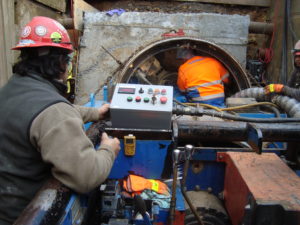 In November and December 2011, the 1.5 m (60 in) and 1.06 m (42 in) SBU-As, respectively, were launched 9.1 m to 10.6 m (30 to 35 ft) beneath a tributary of the Mississippi River. Each utilized an 18.3 m (60 in) ABM to excavate in the hard rock conditions. Both SBU-As broke through on time and within line-and-grade specifications. The first SBU reached completion on December 20, 2011, and its counterpart did the same on February 10, 2012. Each averaged advance rates of 6.1 m (20 ft) per day.
In November and December 2011, the 1.5 m (60 in) and 1.06 m (42 in) SBU-As, respectively, were launched 9.1 m to 10.6 m (30 to 35 ft) beneath a tributary of the Mississippi River. Each utilized an 18.3 m (60 in) ABM to excavate in the hard rock conditions. Both SBU-As broke through on time and within line-and-grade specifications. The first SBU reached completion on December 20, 2011, and its counterpart did the same on February 10, 2012. Each averaged advance rates of 6.1 m (20 ft) per day.
The 1.8 m (72 in) SBU-M was launched in January 2012 from a 7.6 m (25 ft) launch pit. Although the machine encountered an unexpectedly long drive of hard clay just 4.6 m (15 ft) into its bore, crews were able to keep moving by adding water through the cutterhead and the casing. This kept the muck coming through without contaminating the disc cutters.
Although challenging, advance rates of 6.2 m (20 ft) per day were maintained in the softer ground conditions. After about 70.1 m (230 ft) worth of clay, the machine hit solid rock for the remainder of the run. While in hard rock, rates increased to about 90.1 m (30 ft) per day.
On February 14, 2012, the SBU-M broke through into a receiving pit. It finished within line-and-grade requirements with very little deviation, even in the mixed face ground conditions during initial boring.
Nanjing Metro Line 3 Lot 11 & Line 10 Lot 5
Project Overview
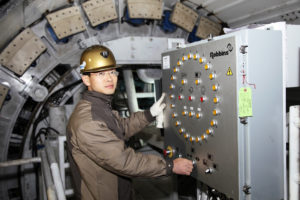 The world-famous Youth Olympic Games were held in Nanjing in summer 2014, bringing 40,000 visitors. This number, combined with the 750,000 people who rode the city’s rails on a daily basis, put the city in need of an extended metro system.
The world-famous Youth Olympic Games were held in Nanjing in summer 2014, bringing 40,000 visitors. This number, combined with the 750,000 people who rode the city’s rails on a daily basis, put the city in need of an extended metro system.
Two new metro lines were built to accommodate the anticipated increase in passengers. Robbins supplied four 6.5 m (21.4 ft) diameter EPBs with mixed ground cutterheads for Line 3 Lot 11 and Line 10 Lot 5, 40.2 km (25.0 mi) and 41.4 km (25.7 mi) long, respectively. The EPBs were part of about 40 TBMs used for the Nanjing Metro expansion.
Ground Conditions
Both lines were bored in soft ground consisting of silty sand, sandstone, small pebbles and man-made materials. The Qinhuai River, old historical structures, a railway and a viaduct were in close vicinity of the lines. Due to the ground conditions and nearby structural constraints, customized excavation methods were employed. The thrust force was kept very low at 6,000 to 9,000 kN (1.4 to 2.0 million lb), continuous monitoring was used to maintain proper alignment and earth pressure, and foam additive was applied to make the ground less sticky and reduce torque.
Excavation
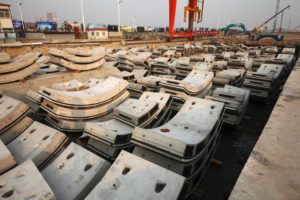 Two of the four 6.5 m (21.4 ft) diameter TBMs were launched for the 2,500 m (8,202 ft) Line 10 Lot 5 in December 2011 and February 2012. The second pair of machines for 2,030 m (6,660 ft) Line 3 Lot 11 began boring soon after in January and March 2012. All machines were assembled and launched from 10 m (33 ft) shafts.
Two of the four 6.5 m (21.4 ft) diameter TBMs were launched for the 2,500 m (8,202 ft) Line 10 Lot 5 in December 2011 and February 2012. The second pair of machines for 2,030 m (6,660 ft) Line 3 Lot 11 began boring soon after in January and March 2012. All machines were assembled and launched from 10 m (33 ft) shafts.
By August 2012, the Line 10 EPBs had excavated 720 m and 600 m (2,362 ft and 1,968 ft), with advance rates of 40 mm (1.6 in) per minute. Over at Line 3, the excavation had progressed as far as 600 m (1,968 ft) with rates topping 60 mm (2.4 in) per minute. Settlement for both lines stayed below the strict required limits of less than 20 mm (0.8 in). By 2013, all four machines had completed their respective tunnels with very favorable results.
The new Lines 3 and 10, now complete, combine with Nanjing’s two existing metro lines to handle the increase in rail riders. The lines will also serve as part of the municipal government’s extensive plan to build 17 new rail routes totaling 600 km (370 mi) across the Yangtze River Basin by 2030.
Shayler Run Segment C Sewer Replacement Project
Project Overview
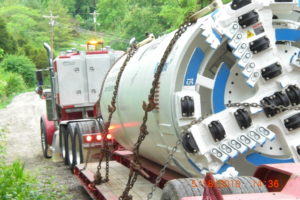 Seven new sewer tunnels were recently completed in Ohio’s Clermont County, replacing an outdated and exposed system that was dumping raw sewage into local Shayler Creek. Since 1978, when the previous pipeline was installed, the creek had eroded, exposing the pipe and putting certain sections of the line at high risk of failure. For all of these reasons, a new pipeline needed to be installed far below the environmentally-sensitive waterway.
Seven new sewer tunnels were recently completed in Ohio’s Clermont County, replacing an outdated and exposed system that was dumping raw sewage into local Shayler Creek. Since 1978, when the previous pipeline was installed, the creek had eroded, exposing the pipe and putting certain sections of the line at high risk of failure. For all of these reasons, a new pipeline needed to be installed far below the environmentally-sensitive waterway.
The Clermont County Water Resources Department hired Indianapolis contractor Midwest Mole for the $15M USD project, and chose to use only one machine for the seven tunnels. A 1.8 m (72 in) diameter Robbins Double Shield Rockhead was used to excavate all of the tunnels, totaling 2,900 m (9,513 ft). The contractor’s unique approach also included eliminating three shafts from the original bid, which shortened the project schedule and significantly lowered costs.
Ground Conditions
Because of the project location below the creek bed, ground conditions were highly varied, consisting of interbedded layers of limestone and shale that ranged from dry to sticky and wet. To accommodate the mixed ground, the machine was outfitted with a mixed ground cutterhead that could be swapped out for a hard rock cutterhead based on the ground conditions at each crossing.
The mixed ground cutterhead featured 6.5 in single disc cutters and carbide bits, while the hard rock cutterhead contained 11.5 in single cutters and abrasion-resistant muck scrapers. Both cutterheads had large openings which allowed for efficient cutter changes.
About the SBU-RHDS
The Robbins Double Shield Rockhead (SBU-RHDS) is a tunneling machine typically used on utility installations of over 150 m (500 ft). Its continuous steering capabilities and laser targeting system make it the ideal solution for line-and-grade critical installations such as the Shayler Run Segment C Sewer Replacement Project.
The SBU-RHDS is available in diameters from 1.4 to 2.0 m (54 to 78 in), and consists of a cutterhead optimized for mixed and hard rock ground conditions. The machine’s circular cutterhead contains disc cutters capable of excavating ground ranging from 25 to 175 MPa (4,000 to over 25,000 psi) UCS.
As the cutterhead rotates, the cutters penetrate the rock face creating “crush zones” through which fractures propagate. Material between adjacent crush zones is then chipped from the face. Muck scrapers scoop the muck into muck buckets, which transfer the muck onto a machine belt conveyor. Muck is transported offsite via conveyor belt or muck cars.
Excavation
 A total of seven tunnel crossings connected by eight shafts were constructed by Midwest Mole. The tunnels utilized the Rockhead, while the shafts were constructed using a combination of drill and blast techniques and manual excavation. A primary liner of ring beams and lagging was installed every 1.5 m (5 ft) at each crossing. Even with liner installation, high production rates of 12 to 18 m (40 to 60 ft) per 12-hour shift were maintained for the project duration.
A total of seven tunnel crossings connected by eight shafts were constructed by Midwest Mole. The tunnels utilized the Rockhead, while the shafts were constructed using a combination of drill and blast techniques and manual excavation. A primary liner of ring beams and lagging was installed every 1.5 m (5 ft) at each crossing. Even with liner installation, high production rates of 12 to 18 m (40 to 60 ft) per 12-hour shift were maintained for the project duration.
Due to the gravity sewer construction, each tunnel had strict line-and-grade requirements of within 300mm (1 ft) of line at 1 to 2% grade, which was continuously monitored from an in-shield operator’s console. Over the course of the project, the variance resulted in a vertical change of 53.9 m (177 ft) causing the machine to bore through a wide range of ground conditions.
Excavation of the initial 484.3 m (1,589 ft) crossing began in May 2010 in mixed ground, and the Rockhead broke through to its first shaft site that August. After a few minor modifications to the hydraulic and muck haulage systems, the machine began boring the second 575.4 m (1,888 ft) crossing.
Crossings 3 and 4, 321.9 m (1,056 ft) and 304.8 m (1,000 ft), respectively, were excavated in December 2010 and January 2011 in adverse winter weather conditions. In order to keep tunneling during freezing temperatures, the contractor heated the machine’s cooling water overnight. Cooling water was recycled and filtered, then stored in 7, 500 l (2,000 gal) tanks with heaters. Using this technique, production rates stayed high and both crossings were successfully excavated by January 2011.
The Rockhead began its fifth and longest crossing of 613.8 m (2,014 ft) in April 2011, and reached a world record in tunneling distance for a hard rock machine of its 1.8 m (72 in) diameter. For the last two crossings, 402.3 m (1,320 ft) and 196.9 m (646 ft), respectively, the mixed ground cutterhead was replaced with its hard rock counterpart.
Due to negotiations with local landowners and a change in shaft location, the final crossing began in January 2012. A month later, the drive was completed. In July 2012, the entire project reached completion right on schedule, with all manholes and ancillary sewers tied in and in service.
Moscow Metro
Project Overview
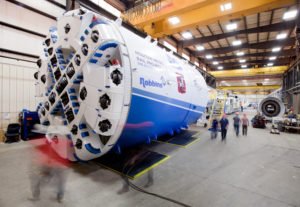 Travel times of over two hours are daily routine for Moscow’s commuters. With a growing population of nearly 12 million, the Moscow Government has issued an extensive city-wide metro project, totaling 50 km (31 mi) of new track by 2018.
Travel times of over two hours are daily routine for Moscow’s commuters. With a growing population of nearly 12 million, the Moscow Government has issued an extensive city-wide metro project, totaling 50 km (31 mi) of new track by 2018.
A total of five Robbins EPBs have bored multiple tunnel drives on the Moscow Metro. Combined, the EPBs have bored more than 8km of tunnel.
Machine Design
All TBMs have been custom designed to handle the area’s complex geology of fine sand, gravel, sandy loam, stiff clays and limestone. Each TBM is equipped with a mixed ground cutterhead capable of switching out carbide cutting tools with disc cutters, depending on conditions.
Besides their mixed ground capabilities, each EPB will utilize a Robbins continuous conveyor system for maximum efficiency during muck removal. Surface monitoring devices will also be employed to limit settlement due to the project’s densely urban environment in the heart of Moscow.
These machines are the first to use electric variable frequency drives (VFDs) in Moscow. The high thrust and torque capabilities of the machines allow for faster excavation while minimizing disturbance that can lead to surface settlement. Active articulation on the machines enables them to excavate tighter curves without the risk of segment deformation that is present when using passive articulation.
Excavation
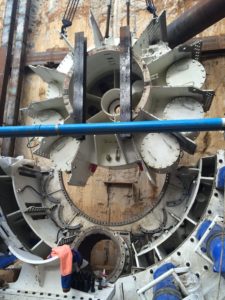 Tunneling occurred at dozens of compact jobsites characterized by Moscow’s challenging mixed ground conditions. Three new Robbins High Performance EPBs and one refurbished machine, named “Julia” operated in various areas of the city. The machines were customized to excavate in the city’s difficult mixed ground geology.
Tunneling occurred at dozens of compact jobsites characterized by Moscow’s challenging mixed ground conditions. Three new Robbins High Performance EPBs and one refurbished machine, named “Julia” operated in various areas of the city. The machines were customized to excavate in the city’s difficult mixed ground geology.
Three Robbins EPB machines were contracted under Engeocom; two 6.6 m diameter machines excavated left and right-hand tunnels, each 1.8 km in length, and “Julia” excavated a 2 km section of a tunnel. A fourth machine contracted under USK MOST is a 6.2 m diameter machine with mixed ground cutterhead that bored a 1.9 km section of a tunnel. All four Robbins machines have also utilized Robbins continuous conveyors for the mixed ground conditions.
When the fourth Robbins machine was launched in winter 2012 from a 15 m deep shaft, contractor USK MOST needed to bore through ground conditions consisting of dense clay and fine sand. They used foam and conditioner to keep the earth balanced, and ultimately for easier muck removal. Not only were they able to keep up with the project’s challenges, but the machine also achieved milestone rates of 150 m in one week, and up to 500 m per month in spring 2013. Experienced crew members, a rigorous schedule, implementation of the continuous conveyor, and the reliability of the Robbins TBM are all factors that helped achieve the record.
Robust Machines, Multiple Drives
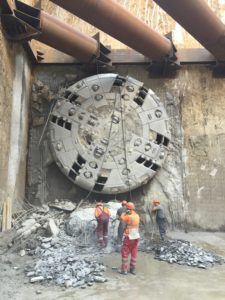 The Robbins EPB for USK MOST made its breakthrough on May 24, 2013. City officials and contractors celebrated not only a record-breaking achievement for the 6.2 m (20.3 ft) diameter mixed ground machine but also finishing ahead of schedule. The TBM achieved a 37.8 m (124 ft) advance in one day at the end of April 2013 – a Russian record for EPBs in the 6 to 7 m (20 to 23 ft) diameter range.
The Robbins EPB for USK MOST made its breakthrough on May 24, 2013. City officials and contractors celebrated not only a record-breaking achievement for the 6.2 m (20.3 ft) diameter mixed ground machine but also finishing ahead of schedule. The TBM achieved a 37.8 m (124 ft) advance in one day at the end of April 2013 – a Russian record for EPBs in the 6 to 7 m (20 to 23 ft) diameter range.
In 2015, a fifth Robbins EPB was added to the mix. The machine was assembled using Onsite First Time Assembly (OFTA) for contractor Evrascon. It bored 4 km of tunnel in hard clay, sand, gravel, pebbles, hard limestone with water, and loam, breaking through in May 2016.
On October 24, 2015, another milestone was reached at the Moscow Metro. A 6.65 m (21.8 ft) diameter Robbins EPB completed its second tunnel, measuring 2.5 km (1.6 mi). The TBM made a breakthrough at its first 2.1 km (1.3 mi) long tunnel drive in January 2014. Contractor SMU Engeocom plans to use the machine on a third tunnel—and that will not be the first time that an EPB has been used on multiple drives at Moscow Metro. Engeocom owns another 6.65 m (21.8 ft) Robbins EPB that completed its second tunnel at the end of September 2015, and will also go on to bore extra tunnels.
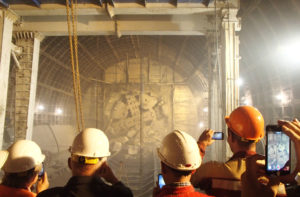
On February 01, 2017 the record-setting Robbins EPB originally for USK MOST started excavation of its fourth bore on the Moscow Metro Project. Its new tunnel will be about 2 km long and will connect stations “Kosino” and “Ulitsa Dmitrievskogo” on the new “Kozhukhovskaya” metro line. The geology is very difficult in this area and running sands are expected. In addition the machine will drive under existing railway tracks. The machine is currently owned by MIP-Story #1 Company—an affiliate of Mosinzhproekt – Main Contractor and Design Institute on the Moscow Metro Project.
The robust Robbins EPBs are capable of even more mixed ground tunnels for the Moscow Metro.

 Close
Close  Menu
Menu 

